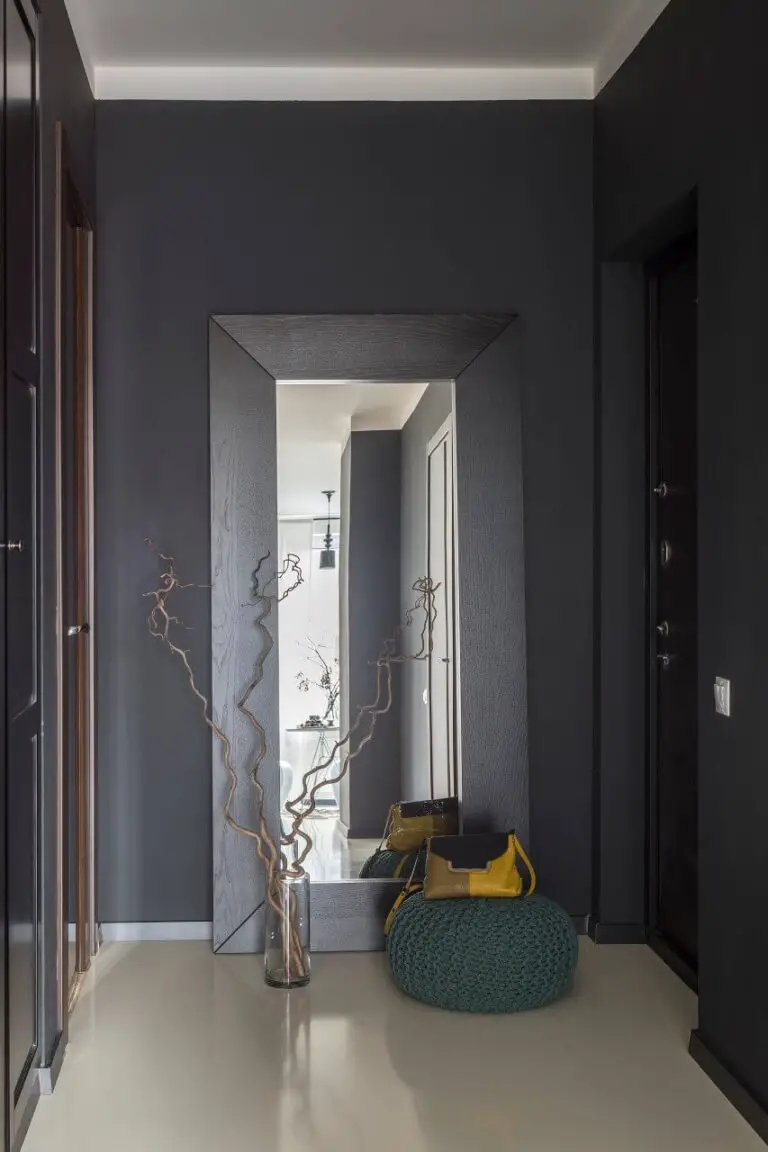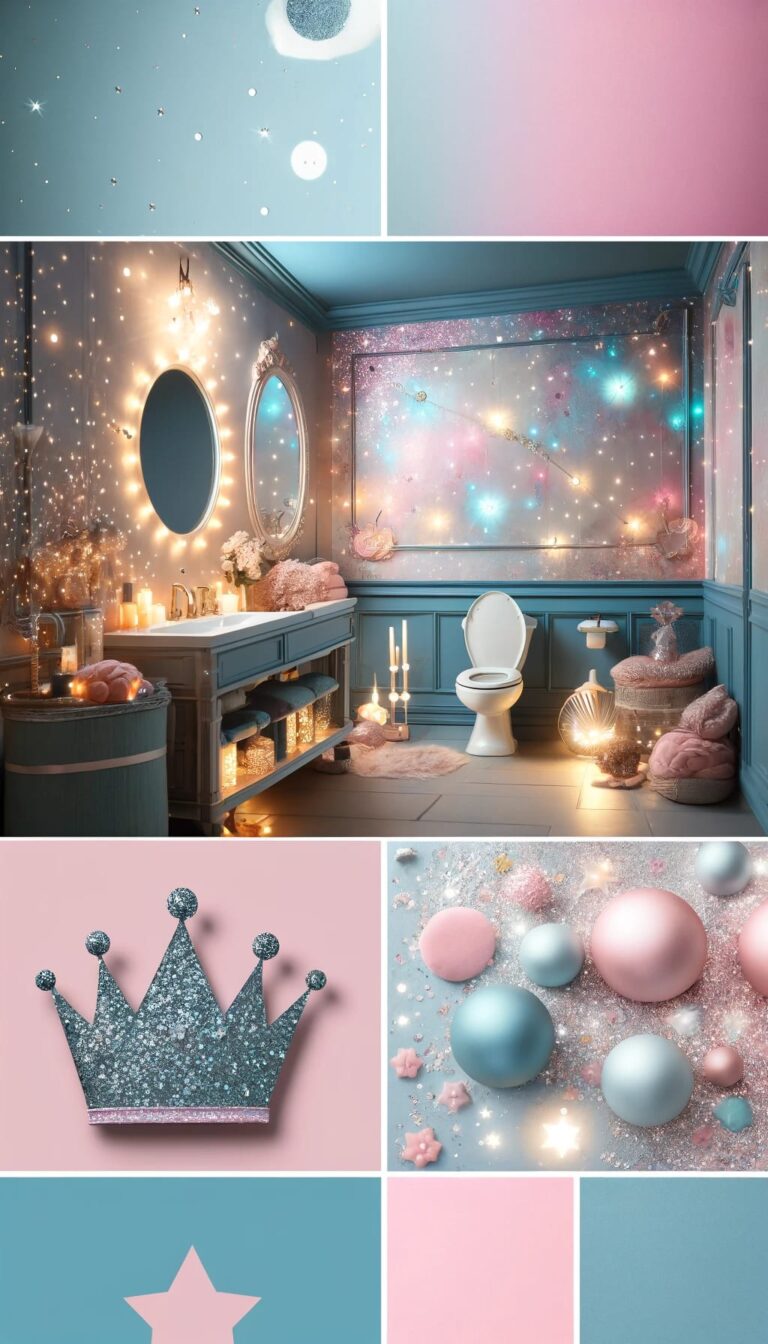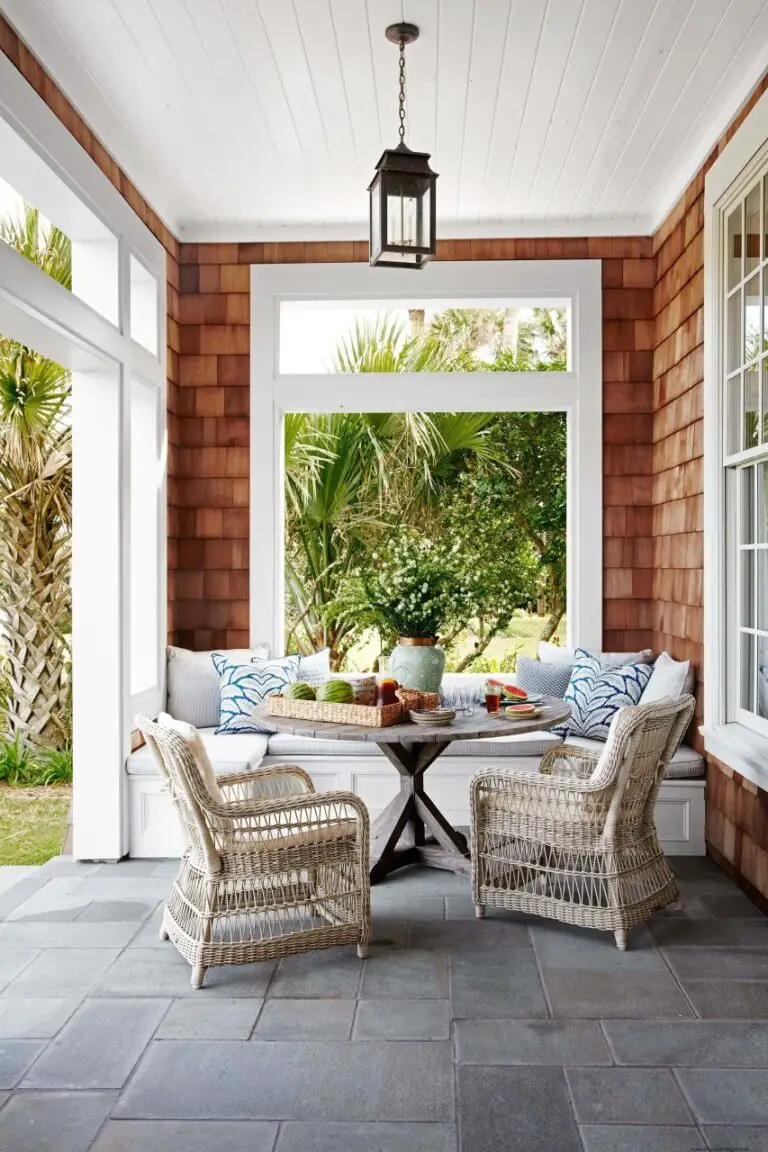44+ Best Tray Ceiling Ideas And Designs
Installing a tray ceiling can elevate the ambiance of any room in your home, allowing you to experiment with lighting fixtures and create a dramatic effect. But what exactly is a tray ceiling? In essence, it’s a type of ceiling design that features a flat, rectangular section of drywall or plywood, often accentuated by molding or other decorative elements. This design element can be used to great effect in various rooms, from bedrooms and living spaces to kitchens and dining areas.
When considering tray ceiling ideas, there are many different schemes you can explore. For example, you might incorporate unique lighting fixtures, such as pendant lights or chandeliers, or use paint colors to create a bold, eye-catching statement. Alternatively, you could opt for a more understated approach, using crown molding or other architectural details to add texture and interest.
No matter which route you choose, the possibilities are endless, and we’ll explore some of our favorite tray ceiling ideas in this article.
What is a tray ceiling?
A tray ceiling, also known as an inverted or recessed ceiling, creates a unique visual effect by featuring a raised center that is several inches higher than the edges of the ceiling. The surrounding borders appear to drop down, creating a sense of depth and dimensionality.
One of the key advantages of a tray ceiling is its ability to be customized with different colors and materials for the trims and surrounding woodwork.
This allows homeowners to create a focal point in any room and add an air of luxury. Tray ceilings are particularly popular in master bedrooms, where they can help create the illusion of more space.
The end result is a visually striking feature that adds depth and visual interest to a room, making it a popular choice for many homeowners.
44 Awesome Tray Ceiling Ideas
When it comes to designing the perfect home, tray ceilings offer a unique opportunity to add visual interest and create a sense of sophistication. With so many options available, it can be overwhelming to decide on the right style. To help you narrow down your choices, we’ve rounded up some of the most inspiring tray ceiling ideas across various design categories, from modern to traditional.
Tray ceiling lighting



When it comes to tray ceilings, one crucial element is often overlooked – lighting fixtures. Upgrading your tray ceiling’s lighting can elevate its overall aesthetic and create a unique ambiance. A prime example of this is seen in this modern kitchen. The clean, elegant design is maintained through the strategic placement of canned lights and a statement pendant light above the kitchen island.
This minimalist approach makes sense given the abundance of natural light provided by the white walls and ceilings. Another way to add depth and visual interest to your tray ceiling is through hidden lighting. The raised edges offer an opportunity to install interior lights that complement other lighting features in the space. Warm yellow track lights or colorful LED string lights are popular choices for creating a variety of hues and adding dramatic flair.
This approach can be used to create a unique light play effect. Alternatively, you can incorporate crown moldings around your tray ceiling to achieve an indirect lighting effect. This compact hallway is a great example of how this design element can be used to create a moody and dramatic ambiance with the addition of a large yellow LED built into the tray ceiling.
Tray ceiling paint ideas



While neutrals are a popular choice for tray ceilings due to their flexibility, there’s no reason why you can’t add some excitement to your design. One way to do this is by introducing bold pops of color through paint patterns. For instance, adding a touch of dark blue to a room dominated by whites creates an intriguing juxtaposition of modern and vintage styles. This look is well-suited to a space that combines bright, white lighting with neutral furniture and colorful decorative accents.
When you want to take things to the next level, consider pairing a magenta tray ceiling with hidden string lighting along the raised edges. The result is nothing short of magical. Alternatively, if you’re looking for an unconventional yet effective design, try incorporating a modern circular tray ceiling that mirrors the mural on your walls. This cohesive look adds sophistication and visual interest to even the most compact of bedrooms.
Reverse tray ceiling



While traditional tray ceilings boast dropping perimeters and sunken centers, their reverse counterparts feature dropped centers and recessed perimeters. For those seeking to push boundaries, here are some innovative ideas for reverse tray ceilings. To achieve a modern, industrial aesthetic, consider abandoning conventional perimeter designs altogether and opting instead for a 3D, embossed look that adds depth and visual interest.
By incorporating hidden lights along the edges and industrial pendant fixtures, you can create a cozy atmosphere in your kitchen.
For an even more avant-garde approach, why not try layering octagonal tray ceilings to minimize their footprint without sacrificing visual impact? A warm, ornate chandelier and neat paintwork can imbue a dining room with a luxurious feel. Alternatively, you could create a standout reverse ceiling tray by interlocking modern, eclectic-style ceiling boxes.
By combining corner canned lights, a central ceiling fan, and organic tones, even the most straightforward room design can be transformed into something truly unique.
Bedroom tray ceiling



Tray ceilings are a timeless design element in master bedrooms, adding an air of elegance and sophistication that sets them apart from other rooms in the home. But these beautiful designs aren’t exclusive to master suites – they can be incorporated into any bedroom to create a unique and inviting space. Consider the following tray ceiling designs to elevate your bedroom’s ambiance.
In this plush bedroom, a multi-paneled tray ceiling creates separation between different areas of the room, adding visual interest and depth. The subtle play of warm lamp lights and recessed cans provides a cozy, intimate atmosphere that makes you feel like you’re in a luxurious retreat. For a rustic yet sophisticated look, incorporate alder wood planks into the tray ceiling’s center to exude warmth and character.
This design element adds a touch of earthiness to an otherwise polished space, creating a balanced and harmonious ambiance. Sometimes, it’s all about finding that perfect balance between style and substance. A traditional-style tray ceiling with a light green and white stripe pattern on the perimeter creates a trendier look that complements neutrals beautifully. This compact bedroom design is a great example of how to achieve a polished yet inviting space through thoughtful design choices.
Living room tray ceiling

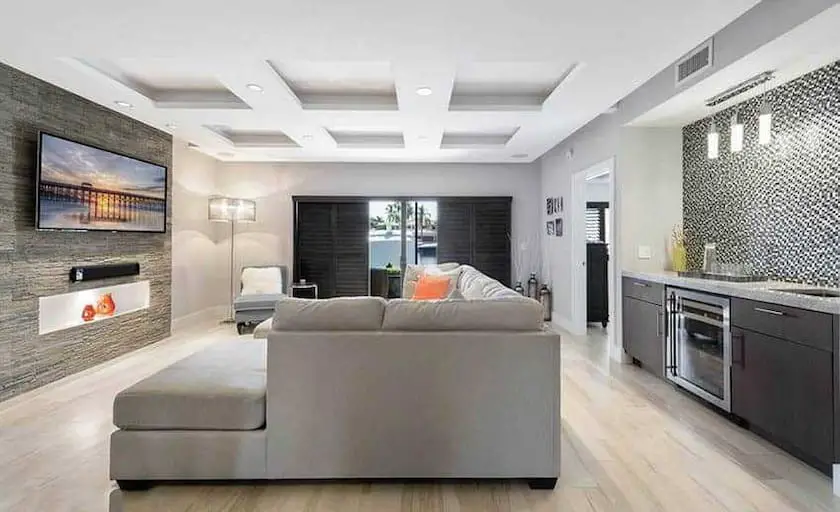

In many homes, a tray ceiling is not limited to just one or two rooms, but rather can be found throughout the entire property. The living room, in particular, is an excellent space where a tray ceiling can truly shine. By adding this design element, you can instantly elevate the look and feel of your main receiving area, making it perfect for entertaining guests.
For instance, a traditional tray ceiling covering the entirety of the living room creates a cohesive and harmonious atmosphere that complements the surrounding décor. The combination of clean lines, symmetry, and subtle recessed lighting creates a sophisticated ambiance that perfectly balances off-white walls, wood accents, and polished stones – including the fireplace. This design approach is not only visually appealing but also creates a sense of grandeur.
For those seeking an even more modern aesthetic, consider installing multiple tray ceilings in your living room. This elegant design feature exudes sophistication and can be used as inspiration for your own unique space. The result is a stunning area that feels like it belongs in a luxurious magazine spread. Lastly, think outside the box (or ceiling) and transform your sunken center into a one-of-a-kind feature by adding tray ceiling wallpaper.
Starting with a traditional tray ceiling and then elevating it to new heights with this creative touch results in a truly unique and captivating space. With tufted and ornate pieces surrounding the area, you’ll be left wondering how you ever lived without such an extraordinary room.
Master bedroom with tray ceiling


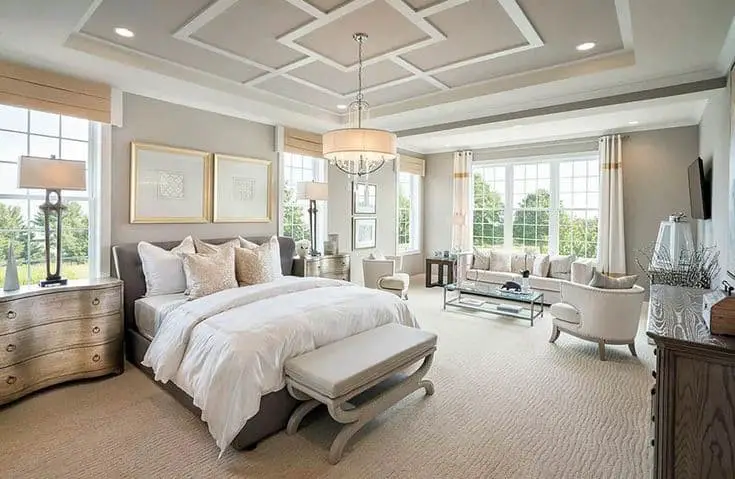
The connection between master’s bedrooms and tray ceilings is profound. The abundance of tray ceiling ideas offers homeowners a plethora of options to elevate their master suites. From traditional square trays to more intricate designs, the possibilities are endless. In this luxurious master suite, the seamless transition from crown moldings to tray ceiling creates an atmosphere of opulence. The sunken center’s perimeter is extended, giving it a dramatic dropping look.
A simple yet effective combination of white paint and bright LED lights brings out the modern flair of the black and gray embellishments. A moody, canopied master suite with rustic undertones is further enhanced by the two-layer tray ceilings. The space is brought to life through a decorative mirror, expansive floor plan, wood accents, and wooden lining around the tray ceiling’s perimeter, which collectively evoke an organic feel.
For a more geometric tone, homeowners can add ornate patterns to the tray ceiling’s center, creating visual interest. By combining this design element with corner canned lights, a chic white chandelier, and a textured pattern, the master suite takes on an airy and spacious quality.
Farmhouse master bedroom tray ceiling



Farmhouse designs are characterized by the use of wood, shiplap, and other rustic decorative elements. Tray ceilings are also a hallmark of this style, and incorporating wood into their design is a great way to add warmth and texture. While it’s not common to cover an entire tray ceiling in wood, there are some beautiful examples out there that do just that.
For instance, using washed cedar wood for the entirety of the tray ceiling can create a distressed, farmhouse look that adds depth and interest to the room. The DIY Mommy is a great source for inspiration on this topic. Another example of an all-wood tray ceiling features X-shaped, exposed beams in oakwood, which gives it a unique and eye-catching design.
When paired with white walls and a distressed center, this look creates a traditional farmhouse master’s bedroom feel that is both cozy and inviting. High ceilings and wood tray ceilings can also create a tropical hotel-inspired atmosphere, perfect for a master’s bedroom. The contrast between the white walls and pinewood tray ceiling in this example is particularly striking, making it a great choice for those who want to add some flair to their home.
Kitchen tray ceiling



We appreciate the understated elegance that tray ceilings bring to a kitchen, adding an upscale touch that’s perfect for modern, industrial or contemporary spaces. This particular design takes on a more traditional flair, yet effectively frames the countertop island, which is often the focal point of a posh bar and kitchen. The polished titanium finish in the sunken center perfectly complements the bust glass countertop, while wood details soften the look and granite tile walls add texture.
Tray ceiling with beams




When it comes to designing a space with a rustic or industrial vibe, incorporating a tray ceiling with beams can be an excellent choice. This design element effectively grounds and earths the room, creating a harmonious atmosphere. In small rooms, such as this compact bedroom, an asymmetrical tray ceiling with exposed beams and a polished finish adds visual interest and dynamics. The contrast between the white surroundings and the tray ceiling’s beams creates a striking focal point.
The minimalist yet luxurious aesthetic of this small bedroom is a testament to the power of thoughtful design. When it comes to revamping a dining room, adding X-shaped exposed beams using stained oakwood in the tray ceiling can be a subtle yet impactful touch. This design element lends itself particularly well to creating a rustic, farmhouse-inspired atmosphere.
For a more dramatic look, consider incorporating multiple tray ceilings with wood beams that frame both the perimeters and interior squares. This classic design element can add depth and visual interest to a room. To create a balanced look, consider recessed lighting installed along the wood beams and in the sunken center of the tray ceiling. The result is a beautiful, modern coastal-inspired living space.
In some cases, a tray ceiling with beams can even serve as a stunning backdrop for a small dining table. In this design, the high ceiling creates a striking focal point that draws the eye upwards. When paired with a modern, chic pendant light, the exposed wood beams in the tray ceiling are further accentuated, encouraging the viewer to take notice of the design’s thoughtful details.
Dining room tray ceiling



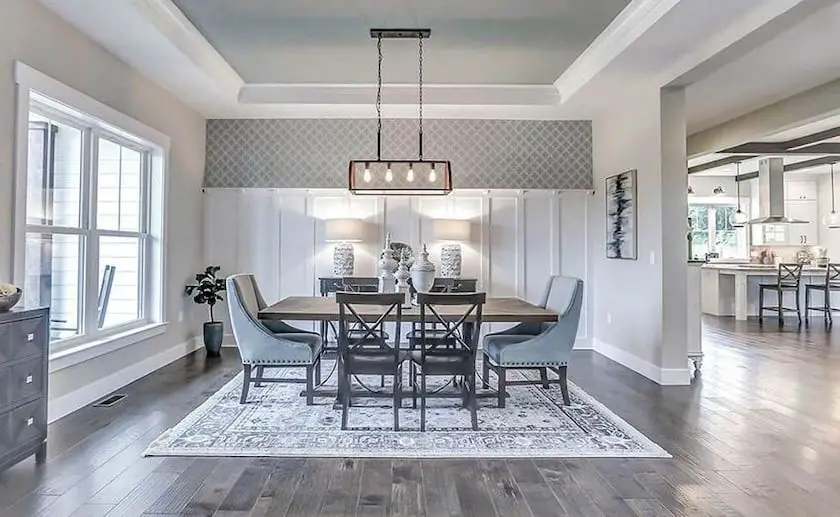
When it comes to designing a dining room with a tray ceiling, the possibilities are truly endless. While often associated with bedrooms and living rooms, tray ceilings can also elevate the ambiance of a dining space. In terms of inlays, concrete and wood remain popular choices for the sunken center of a tray ceiling. However, for those looking to make a statement, marble tile inlays can add a touch of luxury and sophistication.
For a unique and modern look, consider incorporating a reverse tray ceiling into your design. This style is particularly well-suited to high-ceilinged rooms and can create a moody yet cozy atmosphere when paired with pendant lighting. The result is a space that exudes an edgy charm and feels truly contemporary. Alternatively, for a cohesive look that spans multiple rooms, consider a multi-tray ceiling with a coffered design.
This style not only adds visual interest but also creates a sense of continuity between spaces. When done correctly, this look can seamlessly blend modernity and Asian tones, making it perfect for those who appreciate contrast and natural light. Finally, for a traditional take on the tray ceiling, consider framing the entire dining area with a clean, gray, and white color scheme.
The warmth of an industrial pendant light can add a touch of elegance to this look, creating a space that feels both cozy and sophisticated.
Tray ceiling with crown molding



When it comes to achieving a harmonious visual flow in a room, installing crown molding plays a crucial role. By providing a seamless connection between the wall and ceiling, tray ceilings are transformed into a stunning focal point that adds depth and dimensionality. This design approach is particularly effective when combined with octagonal tray ceilings, as seen in this dining room example.
The square crown moldings create a striking contrast with the curved tray ceiling, resulting in a vintage-inspired atmosphere that’s enhanced by the warm lighting fixture and pendant light. Similarly, an oblong shaped tray ceiling can be elevated to new heights when paired with crown moldings that follow its perimeter. In this instance, the ornate patterns on both the molding and ceiling create a sophisticated, Victorian-inspired ambiance.
When it comes to creating a sense of coziness in a neutral-toned space, crown molding can be a game-changer. This bedroom example showcases a dramatic visual effect, thanks to the angled square crown moldings that complement the double tray ceiling with its irregular square shape. The low-level ceiling and 5-light chandelier work together to create a harmonious balance that makes this tray ceiling design truly stand out.
Shiplap tray ceiling



Beyond its rustic and farmhouse design associations, shiplap tray ceilings reveal a surprising versatility. This design element creates an optical illusion of increased space, introducing soft, organic tones to a room’s aesthetic. The polished appearance of vinyl shiplap tray ceilings can be particularly striking in bedrooms, where it frames the bedspace with precision, while crown moldings add a textured dimension for seamless window treatment installation.
For those who appreciate simplicity and understated beauty, this design scheme offers an attractive option. When applied to a double tray ceiling for a kitchen-dining room combination, shiplap tray ceilings emphasize each space while maintaining a cohesive look throughout the area. A neutral color palette in transition rooms, complemented by glass walls that flood the space with natural light, further enhances this elegant design approach.
For compact entryways, shiplap tray ceilings can create a sense of expansive space, injecting texture into an otherwise narrow opening. Paired with white walls, wood accents, and a herringbone central pattern, this traditional farmhouse aesthetic achieves a perfect balance of contrast.
Basement tray ceiling ideas


When planning to revamp your basement into a cozy den, mancave, or family gathering space, consider elevating it with a basement tray ceiling. This design element can drastically improve the aesthetic appeal of an otherwise ordinary area. The example showcased is a stunning home theater, where a sleek black tray ceiling features a polished corner that seamlessly transitions to a matte finish.
The addition of off-white lining and warm lighting creates a luxurious ambiance, making it an ideal setup for movie nights or gaming sessions. For a truly unique man cave and game room experience, consider incorporating exposed wood beams into your basement tray ceiling design. This asymmetrical feature draws attention to the entertainment and seating area, creating a lively atmosphere perfect for social gatherings.
Cathedral tray ceiling


A Cathedral tray ceiling, also known as an angled or vaulted tray ceiling, brings a sense of grandeur and openness to a home. This design option offers a unique opportunity to create a sense of drama and sophistication in various rooms, including the bedroom and bathroom. The vaulted tray ceiling can be particularly striking in a bedroom, where it can add a romantic ambiance and create a sense of luxury.
In this example, the white vaulted tray ceiling allows for even distribution of natural light throughout the room, which complements the moss green walls nicely.
Tray ceiling with wood planks

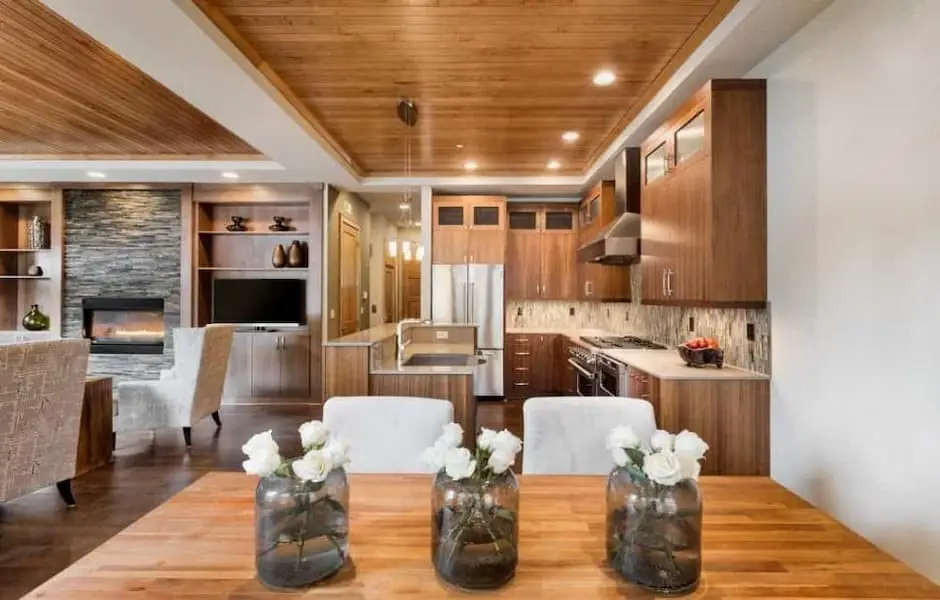
Wooden accents on the ceiling bring a cozy atmosphere to any room, regardless of its overall design aesthetic. In this small dining space, long wood planks at the sunken center create a warm and inviting ambiance. The repurposed branch chandelier adds an industrial touch, making it a standout feature in the room. A similar rustic scheme is achieved by combining polished and stained wood with wood plank tray ceiling panels above.
The well-spaced recessed can lights add a bright and striking element to the space, making it truly unforgettable.
Tray ceiling vs coffered ceiling
While both coffered and tray ceilings share a similar appeal due to their visual intrigue, there exists a fundamental distinction between the two architectural features. Their origins date back to ancient Rome, where they were employed as an innovative means of reducing the weight and volume of stone columns and ceilings.
Coffered ceilings, in particular, are characterized by sunken panels or patterns that can take on various shapes such as square, rectangular, circular, or octagonal grids, thereby creating a three-dimensional effect. In contrast, tray ceilings represent a more minimalist approach to ceiling design, whereby the edges are raised to create a greater angle and an added sense of depth, transforming a previously flat and uninviting ceiling into a visually appealing feature.
Furthermore, coffered ceilings have been shown to enhance a room’s acoustics, whereas tray ceilings serve as a practical means of concealing home vent systems.
Tray ceiling cost
When it comes to installing a tray ceiling, several factors come into play, including the location of your home, the design elements involved, the overall room layout, and the size of the space. While the cost can vary depending on these factors, having a tray ceiling incorporated into the initial construction plan tends to be more budget-friendly. On average, if installed during new construction, you can expect to pay between $500 and $2,000.
In contrast, installing a tray ceiling at a later stage in the home’s development – say, as an add-on or renovation project – can cost anywhere from $1,500 to $3,000, excluding labor costs.
Does a tray ceiling add value to home?
A tray ceiling can significantly enhance the luxurious feel of a home, ultimately yielding a 100% return on investment (ROI) when the property is sold. The resale value of a home with a tray ceiling is directly tied to the complexity and quality of the woodwork incorporated into its design.
Conclusion
While the primary purpose of installing a tray ceiling remains unchanged – adding depth and visual interest to an otherwise flat ceiling – its benefits extend far beyond mere aesthetics. Notably, tray ceilings offer a cost-effective alternative to coffered designs, making them an attractive option for homeowners seeking to elevate their space without breaking the bank. What’s more, the versatility of tray ceiling ideas ensures that you can find a design that suits your unique taste and style.
Ultimately, considering the enhanced aesthetic appeal and potential property value boost that comes with installing a tray ceiling, it’s an investment well worth exploring.

